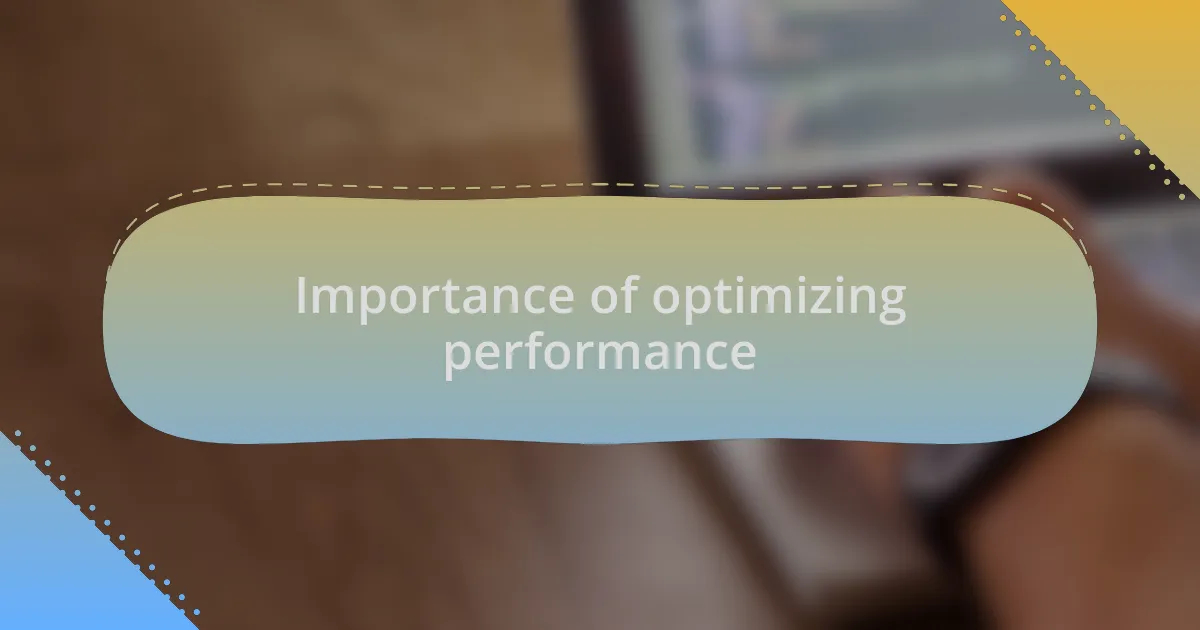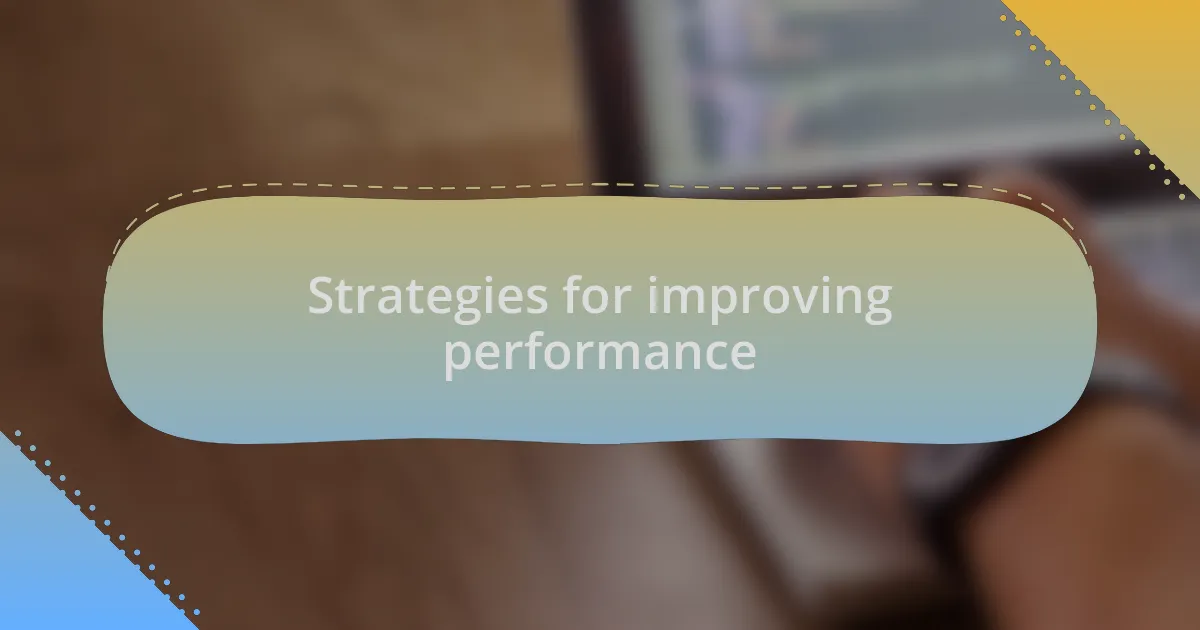Key takeaways:
- Optimizing website performance significantly boosts user satisfaction, retention, and search engine rankings.
- Tools like Google PageSpeed Insights and GTmetrix are essential for analyzing and improving website performance metrics.
- Identifying key performance indicators (KPIs) such as page load time and bounce rate helps in making targeted enhancements.
- Implementing strategies like image optimization and using a CDN can lead to substantial improvements in loading speeds and user engagement.

Understanding performance metrics
Understanding performance metrics is crucial for any website, especially one focused on programming tutorials. When I first delved into this world, I was surprised by how much impact these metrics can have on user engagement. It made me wonder, can the difference between slow and fast loading times truly change the way users interact with content? Absolutely.
One metric that stood out to me was the bounce rate. I remember launching a new tutorial only to find that a significant portion of visitors left within seconds. It’s disheartening to see visitors seemingly uninterested, yet it sparked a deeper exploration into why they were leaving. Could it be the complexity of the content? The loading speed? This prompted me to evaluate every aspect of my site.
Another important factor is page load time. Initially, I underestimated its significance until I noticed that my audience kept dropping off just after a few seconds of waiting. It hits differently when you realize that every second counts. I often ask myself, how can I create swift access to valuable content? Streamlining images and utilizing caching made a noticeable difference, underscoring the fact that performance metrics are not just numbers but reflections of user experience.

Importance of optimizing performance
Optimizing performance is essential because it directly impacts user satisfaction and retention. I remember the excitement of launching a new series of tutorials, only to realize that slow loading times resulted in frustrated users clicking away. It made me think: how many eager learners did I lose simply because they didn’t have the patience to wait? The truth is, a seamless experience fosters loyalty.
Moreover, improving website performance enhances search engine rankings. When I learned that faster sites tend to rank higher, it motivated me to dive deeper into optimization techniques. I recall implementing a content delivery network (CDN), which significantly sped things up. Driving more traffic became less about luck and more about creating an efficient platform for my audience.
Finally, the psychological aspect of speed cannot be overlooked. The thrill of instant access to knowledge propels curiosity and engagement. Once I optimized my site, I could sense the difference in user interactions. People were not just visiting; they were exploring, commenting, and returning. Isn’t it rewarding to witness a community thrive as a direct result of performance improvement?

Tools for performance analysis
When it comes to analyzing website performance, tools like Google PageSpeed Insights have become my go-to. The first time I entered my site’s URL, I was both excited and anxious about the results. Those actionable insights into loading times and suggestions for improvement were pivotal in helping me see where I could trim the fat on my pages. Have you ever felt that rush when you see how small tweaks can lead to big improvements? It’s empowering.
Another tool I found incredibly useful is GTmetrix. Its ability to break down various metrics like fully loaded time and page size helped me understand the bigger picture. I remember diving into the waterfall chart it provides, which laid out everything happening on my site in a visual format. This clarity allowed me to pinpoint performance bottlenecks that I otherwise might have overlooked.
For real-time monitoring, I swear by New Relic. When I implemented it, I was stunned to learn how heavy certain scripts were dragging my site down. It was almost like discovering hidden weights that were slowing me down without me realizing it. Seeing those metrics in real-time has not only helped me make immediate adjustments but also fostered a habit of ongoing optimization. Have you found tools that changed your outlook on performance analysis? If so, I’d love to hear about them!

Identifying key performance indicators
Identifying key performance indicators (KPIs) is essential for anyone looking to enhance their website. For me, starting this process felt like putting together a puzzle; each piece represented a different aspect of how users interact with my site. I found that focusing on metrics such as page load time, bounce rate, and user engagement gave me a clearer picture of my site’s health. What are the specific indicators that resonate with your experience?
One day, while reviewing my analytics, I discovered that the average session duration was lower than I’d anticipated. This revelation prompted me to delve deeper into user behavior; it made me wonder what was causing visitors to leave so quickly. By setting goals around these metrics, I’ve been able to make targeted enhancements that ultimately increased not only visitor satisfaction but also conversion rates. Have you ever tracked progress toward a specific KPI that transformed your approach?
Lastly, I realized that looking beyond just traffic numbers is crucial. For example, monitoring the success rate of tutorial completions highlighted how effectively I was delivering content. This insight transformed my focus, prompting me to enhance clarity and engagement in my tutorials. Your KPIs should tell a story—what story do yours reveal?

Strategies for improving performance
Improving website performance involves a multifaceted approach that tackles various elements of user experience. One effective strategy I’ve embraced is optimizing images, as large files can significantly slow down page load times. When I started compressing images and using modern formats like WebP, I noticed not only faster loading speeds but also a drop in bounce rates. Have you ever wondered how small changes like these can lead to big wins?
Another vital strategy is streamlining code. I recall a time when an excessive number of scripts on the site led to frustrating delays in loading. By prioritizing essential scripts and deferring non-critical ones, I enhanced both the speed and the overall flow of user interactions. This simple adjustment made a remarkable impact on user retention. How have you approached code optimization in your own projects?
Additionally, implementing a content delivery network (CDN) has been a game changer for overall performance. When I first transitioned my site to use a CDN, I felt a mix of skepticism and hope. However, the reduction in load times across different geographical locations was astonishing, enhancing my global audience’s experience significantly. Isn’t it empowering to see how a well-chosen tool can expand reach while improving performance?

My personal optimization journey
It’s fascinating to reflect on my personal optimization journey. One pivotal moment for me was when I first realized the impact of caching. I still remember the thrill of configuring browser caching and seeing the immediate drop in load times on repeat visits. That feeling of making my site more user-friendly was truly satisfying. Have you ever experienced that rush of joy from a technical success?
As I delved deeper, I became more aware of the importance of analytics. I vividly recall the day I uncovered insights from user behavior that guided my optimization efforts. Understanding where users faltered allowed me to make targeted improvements, turning frustration into seamless navigation. It’s amazing how data can illuminate paths you didn’t even know existed. How has analytics shaped your approach to optimization?
Each step of this journey has been a learning experience. I was surprised at how often minor adjustments in website architecture led to noticeable performance boosts. The moment I reorganized my site’s hierarchy and improved internal linking, I felt a surge of pride in seeing visitors explore more pages. Isn’t it rewarding to witness the fruits of your labor reflected in user engagement?

Lessons learned from performance tuning
Tuning performance metrics taught me that every tiny detail matters. I once overlooked image optimization and used high-resolution photos without realizing they were slowing my site down. After compressing those images, I was amazed by the dramatic reduction in load times and how much smoother the user experience became. Can you believe the difference a simple action like that can make?
Another lesson I learned was the significance of mobile responsiveness. When I first analyzed my site’s performance on different devices, it was eye-opening to see how much my desktop-centric design was hindering mobile users. Adjusting the layout for mobile not only improved load times but also increased my mobile traffic. Have you taken the time to evaluate your site’s mobile experience?
Finally, I discovered that continuous performance monitoring is key to long-term success. I implemented real-time performance tracking tools, which revealed issues I would have never noticed otherwise. The constant feedback loop helped me stay proactive, making incremental changes that kept my site running smoothly. Isn’t it empowering to have that kind of insight at your fingertips?